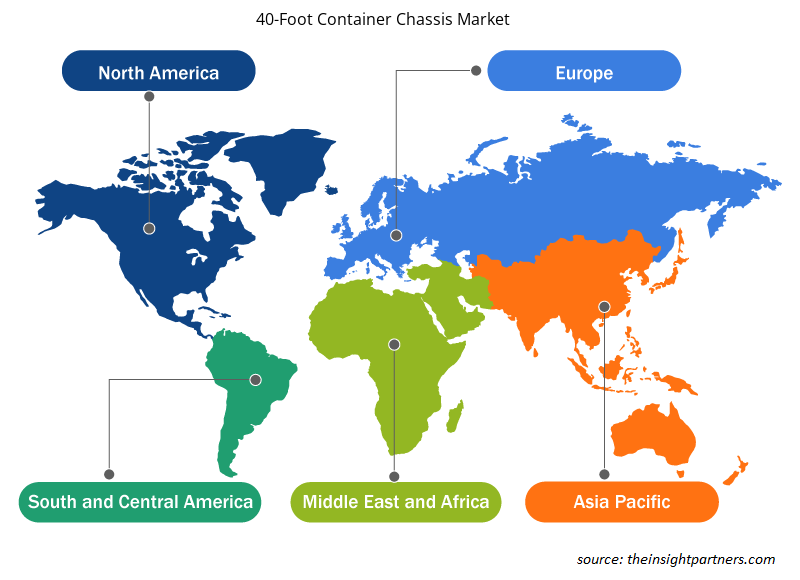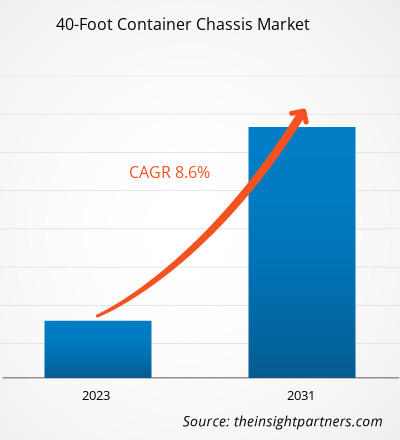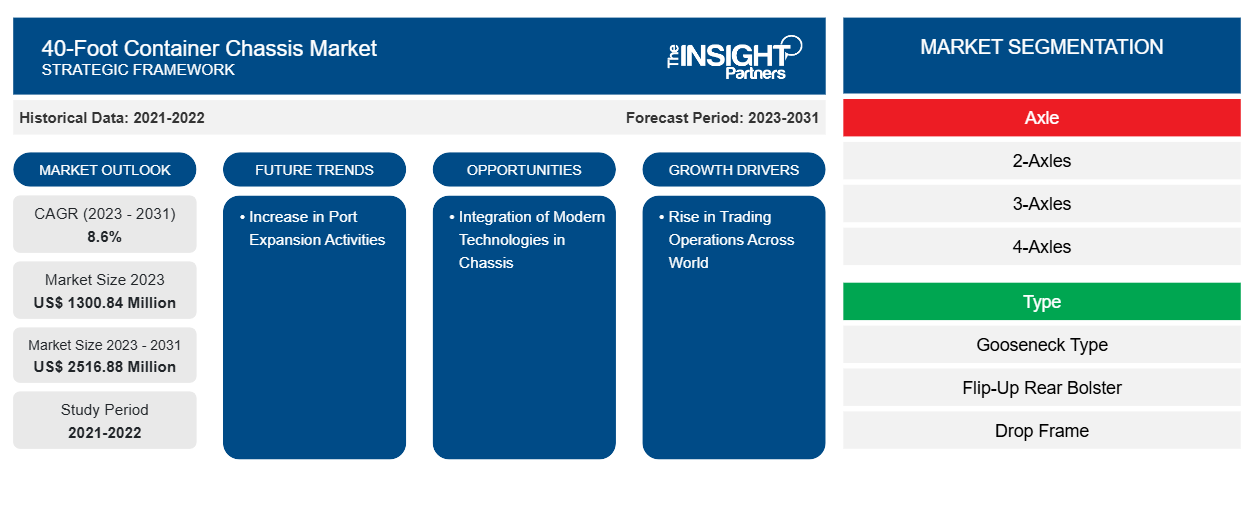Der Markt für 40-Fuß-Containerchassis soll von 1300,84 Millionen US-Dollar im Jahr 2023 auf 2516,88 Millionen US-Dollar im Jahr 2031 anwachsen. Der Markt soll im Zeitraum 2023–2031 eine durchschnittliche jährliche Wachstumsrate (CAGR) von 8,6 % verzeichnen. Die Nachfrage nach 40-Fuß-Containern wächst mit der Zunahme der Handelsaktivitäten weltweit. Diese Container werden für den nationalen und internationalen Versand von Gütern mit großem Volumen verwendet, da sie eine große Menge an Ladung aufnehmen können. Angesichts der zunehmenden Verbreitung von 40-Fuß-Containern weiten die Hersteller ihre Produktionsabläufe aus, was die Nachfrage nach Chassis für diese Container ankurbelt. Darüber hinaus bringen sie neue Produkte mit zusätzlichen Funktionen auf den Markt, um ihren Umsatz und Kundenstamm zu steigern.
Marktanalyse für 40-Fuß-Containerchassis
Regulierungsbehörden und Vorschriften wie die Federal Motor Carrier Safety Administration (FMCSA), das Container Safety Certificate (CSC) und die Internationale Organisation für Normung (ISO) haben einen starken Einfluss auf die Herstellung und den Verkauf von Containerfahrgestellen. Im Februar 2021 setzte die Federal Motor Carrier Safety Administration (FMCSA) ihre Intermodal Chassis-Regel durch, die Anbieter von Intermodalausrüstung (IEPs), Spediteure und Fahrer verpflichtet, die Verantwortung für die Sicherheit der auf Autobahnen eingesetzten Intermodalausrüstung zu teilen. Darüber hinaus wird erwartet, dass staatliche Investitionen in die Autobahn- und Straßeninfrastruktur zur Verbesserung der Qualität von Straßen, Eisenbahnen, Häfen und des Luftverkehrs in den kommenden Jahren die Nachfrage nach Containerfahrgestellen ankurbeln werden. Eine verbesserte Transportinfrastruktur würde die Logistikabläufe im kommerziellen und industriellen Sektor ankurbeln und so zur sicheren und pünktlichen Lieferung von Waren und Dienstleistungen beitragen. Im März 2023 kündigte die Provinzregierung von Neufundland und Labrador eine Investition von ca. 1,4 Milliarden US-Dollar an, um die Straßen- und Autobahntransportinfrastruktur in den nächsten fünf Jahren zu verbessern. Im März 2023 kündigte die britische Regierung Pläne an, in den nächsten zwei Jahren landesweit rund 43,50 Milliarden US-Dollar (40 Milliarden Pfund) in bahnbrechende Transportprojekte zu investieren. 40-Fuß-Containerchassis werden in verschiedenen gewerblichen und industriellen Transporten eingesetzt. Daher werden staatliche Investitionen zur Stärkung der gewerblichen und industriellen Wirtschaftssegmente durch die Verbesserung der Straßen- und Autobahninfrastruktur im Prognosezeitraum voraussichtlich vielversprechende Wachstumschancen für den Markt für 40-Fuß-Containerchassis bieten.
Marktübersicht für 40-Fuß-Containerchassis
Der Markt für 40-Fuß-Containerchassis wird im Allgemeinen von Anbietern intermodaler Ausrüstung (IEP), Reedereien und Spediteuren genutzt, die den regionalen und lokalen Transport von Containern mit LKWs durchführen. Chassis werden zum Transport von Containern von Ladeflächen zum Hof sowie zu Lagerflächen an Terminals verwendet. Die Chassissysteme sind stark und robust und schützen Container während des Transports vor den Auswirkungen scharfer und plötzlicher Bewegungen und gewährleisten so einen effizienten und sicheren Transport.
Passen Sie diesen Bericht Ihren Anforderungen an
Sie erhalten kostenlos individuelle Anpassungen an jedem Bericht, einschließlich Teilen dieses Berichts oder einer Analyse auf Länderebene, eines Excel-Datenpakets sowie tolle Angebote und Rabatte für Start-ups und Universitäten.
-
Holen Sie sich die wichtigsten Markttrends aus diesem Bericht.Dieses KOSTENLOSE Beispiel umfasst eine Datenanalyse von Markttrends bis hin zu Schätzungen und Prognosen.
Markttreiber und Chancen für 40-Fuß-Containerchassis
Anstieg der Handelsaktivitäten weltweit
Laut der Welthandelsorganisation (WTO) ist der Welthandel seit 1995 im Jahr 2022 mengenmäßig um 4 % und wertmäßig um 6 % jährlich gestiegen. Die Globalisierung ist einer der Hauptgründe für das Wachstum des Welthandels. Ein daraus resultierender Anstieg der Nachfrage nach Versandgütern führt zu einem Bedarf an Containerchassis zum Transport von 40-Fuß-Containern. Darüber hinaus ist der Einsatz dieser Chassis nicht auf den Transport von Gütern über See und Land beschränkt. Sie werden auch für den intermodalen Transport von Containern mit verschiedenen Transportmitteln wie Schiffen, Zügen und Lkws verwendet. Somit fördern die kontinuierlich wachsenden Handelsaktivitäten auf der ganzen Welt das Wachstum des Marktes für 40-Fuß-Containerchassis.
Integration moderner Technologien ins Fahrwerk
Die Integration des IoT in Fahrgestellsysteme hat eine starke Konnektivität zwischen dem Fahrgestell und anderen Komponenten einer Lieferkette ermöglicht, was zu einer verbesserten Sichtbarkeit und Echtzeitverfolgung der Fracht auf Telefonen oder Computern führt. Das IoT wird wahrscheinlich in diese Fahrgestelle extrapoliert, um deren Effizienz zu steigern. Darüber hinaus werden fortschrittliche Technologien wie Telematik verschiedene Vorteile zugeschrieben, wenn sie in intermodale Fahrgestelle integriert werden. Telematik kann das Personal auf dem Laufenden halten, indem sie Informationen über Abfahrt und Ankunft des Fahrgestells liefert, was Abrechnungsstreitigkeiten lösen und Diebstähle verhindern würde. Es hilft auch bei der besseren Verwaltung von Lieferketten und Frachtnetzwerken.
40-Fuß-Container-Chassis Marktbericht Segmentierungsanalyse
Schlüsselsegmente, die zur Ableitung der Marktanalyse für 40-Fuß-Containerfahrgestelle beigetragen haben, sind Typ und Achse.
- Basierend auf dem Typ ist der Markt in 2-Achsen, 3-Achsen und 4-Achsen unterteilt. Das 2-Achsen-Segment hatte im Jahr 2023 einen größeren Marktanteil.
- Basierend auf dem Typ ist der globale Markt für 40-Fuß-Containerchassis in Unter-Schwanenhals, hochklappbare Heckpolster, geraden Rahmen und Drop-Frame unterteilt. Das Schwanenhalssegment hatte 2023 einen größeren Marktanteil.
Marktanteilsanalyse für 40-Fuß-Containerchassis nach geografischer Lage
Geografisch ist der nordamerikanische Markt für 40-Fuß-Containerchassis in die USA, Kanada und Mexiko unterteilt. Die Region ist Vorreiter bei der Einführung und Erweiterung ihrer Geschäftskapazitäten, um der wachsenden Kundennachfrage gerecht zu werden. Mit der Globalisierung steigt die Nachfrage nach Waren und Dienstleistungen, die über internationale Grenzen transportiert werden. Die Import- und Exportaktivitäten in der Region nehmen zu. Laut dem Bureau of Economic Analysis beispielsweise nahmen die Import- und Exportaktivitäten zwischen den USA und China im Jahr 2022 im Vergleich zu 2021 zu. Daher erfordert dieser erhöhte Warenhandel große Container und Chassis, um die Waren von Häfen und Lagern zu transportieren. Um dieser Nachfrage gerecht zu werden, ergreifen die Marktteilnehmer strategische Initiativen, um den Verkauf von 40-Fuß-Containerchassis anzukurbeln. So übernahmen GIC, OMERS Infrastructure und Wren House im Juni 2022 gemeinsam Direct Chassis Link Inc. (DCLI), ein Chassis-Leasingunternehmen in den USA. Diese Übernahme wird die Fähigkeiten von DCLI stärken, mehr Kunden zu erreichen und die ständige Unterstützung von GIC, OMERS Infrastructure und Wren House zu nutzen. Darüber hinaus bauen die Marktteilnehmer neue Chassis-Produktionseinheiten, um der steigenden Nachfrage nach Chassis angesichts des Chassis-Mangels in den USA gerecht zu werden. So eröffnete das in Kalifornien ansässige Unternehmen CIE Manufacturing (CIEM) im Oktober 2020 sein neues Chassis-Produktionswerk in Virginia und brachte sein erstes Container-Chassis auf den Markt. Ziel des Baus dieser Produktionsanlage war die Herstellung von Chassis, die in der Lage sind, 40-Fuß- und 40/45-Fuß-Intermodalcontainer zu transportieren. Darüber hinaus erweiterte CIEM 2020 sein kalifornisches Produktionswerk. Im März 2022 ging TRAC Intermodal eine Partnerschaft mit American Made Chassis (AMC) ein, um neue 40-Fuß-Container-Chassis für den Seeverkehr herzustellen und zu liefern. Strategische Partnerschaften zwischen den Marktteilnehmern zur Herstellung von 40-Fuß-Container-Chassis führen zu einer verstärkten Zusammenarbeit bei Design, Herstellung und Vertriebskapazitäten der Marktteilnehmer und tragen so zum Wachstum des Marktes für 40-Fuß-Container-Chassis in Nordamerika bei.
Regionale Einblicke in den Markt für 40-Fuß-Containerchassis
Die regionalen Trends und Faktoren, die den Markt für 40-Fuß-Containerchassis im gesamten Prognosezeitraum beeinflussen, wurden von den Analysten von Insight Partners ausführlich erläutert. In diesem Abschnitt werden auch die Marktsegmente und die Geografie von 40-Fuß-Containerchassis in Nordamerika, Europa, im asiatisch-pazifischen Raum, im Nahen Osten und Afrika sowie in Süd- und Mittelamerika erörtert.

- Erhalten Sie regionale Daten zum Markt für 40-Fuß-Containerchassis
Umfang des Marktberichts für 40-Fuß-Containerchassis
| Berichtsattribut | Details |
|---|---|
| Marktgröße im Jahr 2023 | 1300,84 Millionen US-Dollar |
| Marktgröße bis 2031 | 2516,88 Millionen US-Dollar |
| Globale CAGR (2023 - 2031) | 8,6 % |
| Historische Daten | 2021-2022 |
| Prognosezeitraum | 2023–2031 |
| Abgedeckte Segmente |
Nach Achse
|
| Abgedeckte Regionen und Länder |
Nordamerika
|
| Marktführer und wichtige Unternehmensprofile |
|
Marktteilnehmerdichte: Der Einfluss auf die Geschäftsdynamik
Der Markt für 40-Fuß-Containerchassis wächst rasant, angetrieben von der steigenden Nachfrage der Endnutzer aufgrund von Faktoren wie sich entwickelnden Verbraucherpräferenzen, technologischen Fortschritten und einem größeren Bewusstsein für die Vorteile des Produkts. Mit steigender Nachfrage erweitern Unternehmen ihr Angebot, entwickeln Innovationen, um die Bedürfnisse der Verbraucher zu erfüllen, und nutzen neue Trends, was das Marktwachstum weiter ankurbelt.
Die Marktteilnehmerdichte bezieht sich auf die Verteilung der Firmen oder Unternehmen, die in einem bestimmten Markt oder einer bestimmten Branche tätig sind. Sie gibt an, wie viele Wettbewerber (Marktteilnehmer) in einem bestimmten Marktraum im Verhältnis zu seiner Größe oder seinem gesamten Marktwert präsent sind.
Die wichtigsten Unternehmen auf dem Markt für 40-Fuß-Containerfahrgestelle sind:
- Chassis King Inc
- Fliegl Fahrzeugbau GmbH
- Cheetah Chassis Corp
- Triton International Ltd
- Karl Kassbohrer Fahrzeugwerke GmbH
- CIE-Herstellung
Haftungsausschluss : Die oben aufgeführten Unternehmen sind nicht in einer bestimmten Reihenfolge aufgeführt.

- Erhalten Sie einen Überblick über die wichtigsten Akteure auf dem Markt für 40-Fuß-Containerchassis
Marktnachrichten und aktuelle Entwicklungen zum 40-Fuß-Containerchassis
Der Markt für 40-Fuß-Containerchassis wird durch die Erfassung qualitativer und quantitativer Daten nach Primär- und Sekundärforschung bewertet, die wichtige Unternehmensveröffentlichungen, Verbandsdaten und Datenbanken umfasst. Im Folgenden finden Sie eine Liste der Entwicklungen auf dem Markt für Innovationen, Geschäftserweiterungen und Strategien:
- Im April 2022 bringt Triton TAL Chassis unter das Dach seiner Hauptmarke. Das Unternehmen konzentrierte sich weiterhin auf das Leasing von Chassis über einen längeren Zeitraum und den Direktvertrieb an Kunden, die nach flexiblen, kostengünstigen Lösungen und durchdachten und innovativen Leasingstrukturen suchen. (Quelle: Triton, Pressemitteilung)
- Im April 2022 starteten Kässbohrer und die CM Logistik Gruppe ihre neue Partnerschaft mit 40 mittig und hinten ausziehbaren multifunktionalen Containerchassis vom Typ K.SHG AMH. (Quelle: Kässbohrer, Pressemitteilung)
Marktbericht zu 40-Fuß-Containerchassis: Abdeckung und Lieferumfang
Der Bericht „Marktgröße und Prognose für 40-Fuß-Containerchassis (2021–2031)“ bietet eine detaillierte Analyse des Marktes, die die folgenden Bereiche abdeckt:
- Marktgröße und Prognose für 40-Fuß-Containerchassis auf globaler, regionaler und Länderebene für alle abgedeckten wichtigen Marktsegmente.
- Marktdynamik wie Treiber, Beschränkungen und wichtige Chancen
- Markttrends für 40-Fuß-Containerchassis
- Detaillierte PEST/Porters Five Forces- und SWOT-Analyse
- Marktanalyse für 40-Fuß-Containerchassis, die wichtige Markttrends, globale und regionale Rahmenbedingungen, wichtige Akteure, Vorschriften und aktuelle Marktentwicklungen umfasst
- Branchenlandschaft und Wettbewerbsanalyse für 40-Fuß-Containerchassis, einschließlich Marktkonzentration, Heatmap-Analyse, prominenten Akteuren und aktuellen Entwicklungen.
- Detaillierte Firmenprofile
- Historische Analyse (2 Jahre), Basisjahr, Prognose (7 Jahre) mit CAGR
- PEST- und SWOT-Analyse
- Marktgröße Wert/Volumen – Global, Regional, Land
- Branchen- und Wettbewerbslandschaft
- Excel-Datensatz
Aktuelle Berichte
Verwandte Berichte
Erfahrungsberichte
Grund zum Kauf
- Fundierte Entscheidungsfindung
- Marktdynamik verstehen
- Wettbewerbsanalyse
- Kundeneinblicke
- Marktprognosen
- Risikominimierung
- Strategische Planung
- Investitionsbegründung
- Identifizierung neuer Märkte
- Verbesserung von Marketingstrategien
- Steigerung der Betriebseffizienz
- Anpassung an regulatorische Trends























 Kostenlose Probe anfordern für - Markt für 40-Fuß-Containerchassis
Kostenlose Probe anfordern für - Markt für 40-Fuß-Containerchassis